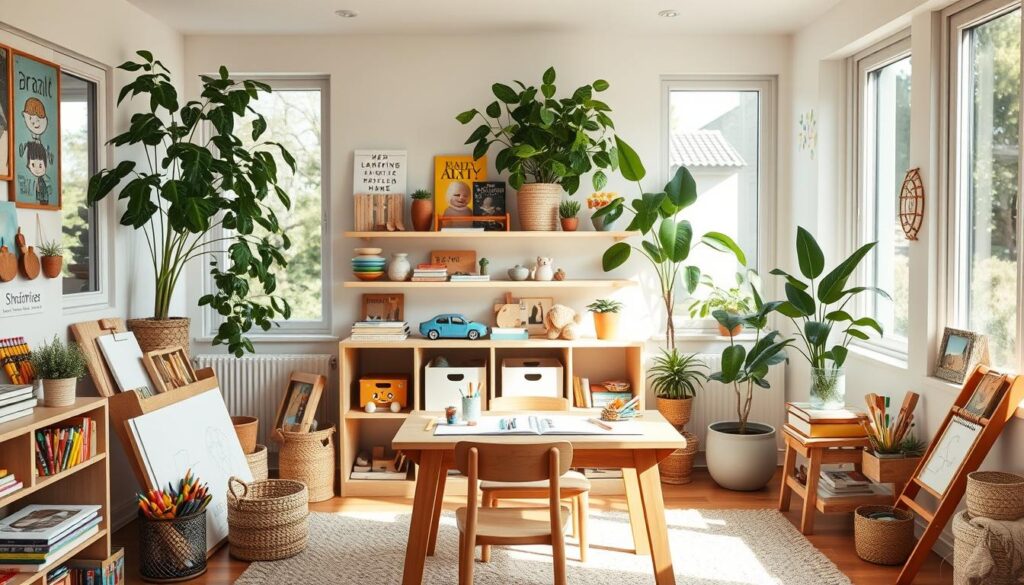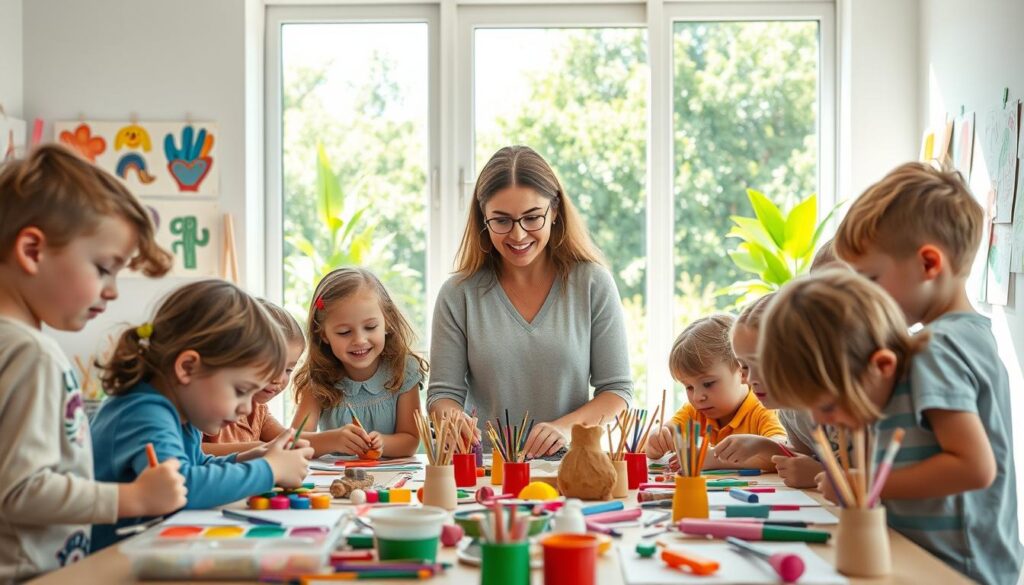Can we nurture the next generation of creative thinkers and problem solvers? As a parent and educator, I’ve seen firsthand how early childhood experiences shape a child’s ability to think outside the box and explore new ideas.
Lunesia’s approach to fostering creativity is rooted in understanding that children’s imaginative abilities are essential building blocks for cognitive and emotional growth. By providing a nurturing environment, we can help our children develop a lifelong love of learning and creative thinking.
In this article, we’ll explore how Lunesia’s methods can transform your child’s creative thinking through purposeful play and exploration, and provide you with practical strategies to implement at home.
Understanding Creativity and Imagination in Early Childhood
The early years of a child’s life are marked by an innate curiosity that fuels their creativity and imagination. As they explore and interact with their environment, they begin to develop these essential skills.
What Defines Creativity and Imagination in Young Children
Creativity involves generating novel ideas and solutions through original thinking, while imagination is the ability to create mental images and scenarios beyond reality. I’ve observed that creativity in young children manifests as their natural ability to think flexibly and generate unique ideas. Research shows that creative thinking develops alongside other crucial skills like language acquisition and logical reasoning.
The Developmental Significance of Creative Thinking
The developmental significance of creativity cannot be overstated. Through imaginative play, children learn to problem-solve, develop empathy, and build neural pathways that support their learning throughout life. Children who engage in creative processes show enhanced abilities to generate multiple solutions to problems and demonstrate greater cognitive flexibility.
How Lunesia Fosters Creativity and Imagination
Our method at Lunesia is centered around the idea that creativity is not just a skill, but a way of thinking. We believe that by fostering creativity and imagination, we can help children develop into innovative problem-solvers. At Lunesia, we understand that creativity is a vital component of a child’s development, and we’re dedicated to nurturing it through thoughtful guidance and the right environment.

The Lunesia Approach to Creative Development
The Lunesia approach focuses on providing children with the tools, space, and freedom to explore their own creative potential. We carefully select materials that are open-ended and versatile, allowing children to transform them according to their imagination. Our educators are trained to ask thought-provoking questions that extend children’s thinking without directing their creative process.
Core Principles Behind Lunesia’s Creative Philosophy
Our core principles include emphasizing process over product, encouraging risk-taking, and celebrating diverse forms of expression. We believe that children learn best when they feel safe to experiment, make mistakes, and discover solutions on their own terms. The Lunesia environment is intentionally designed to stimulate curiosity, with thoughtfully arranged spaces that invite exploration and discovery through multiple senses.
| Core Principle | Description | Benefit |
|---|---|---|
| Emphasizing Process Over Product | Focus on the creative journey rather than the end result | Encourages experimentation and learning |
| Encouraging Risk-Taking | Support children in taking creative risks | Builds confidence and resilience |
| Celebrating Diverse Forms of Expression | Value different forms of creative expression | Fosters creativity and individuality |
The Cognitive and Emotional Benefits of Creative Play
The benefits of creative play extend far beyond the playground, enhancing both cognitive skills and emotional well-being in children. As I’ve observed, creative play is not just a form of entertainment but a vital component of a child’s development.
Enhancing Problem-Solving and Critical Thinking Skills
Engaging in creative activities strengthens children’s problem-solving skills and critical thinking. When children are involved in creative processes, they learn to evaluate options, make decisions, and develop persistence—essential skills for academic success and lifelong learning.
Building Emotional Intelligence Through Creative Expression
Creative expression provides a healthy outlet for children to process complex emotions. Through art, music, and storytelling, children develop emotional vocabulary and awareness, laying the foundation for empathy and emotional intelligence.
Developing Social Skills Through Collaborative Creativity
Collaborative creative activities significantly improve social reciprocity in children, teaching them valuable skills like turn-taking, sharing ideas, and appreciating different perspectives. As children create together, they learn to negotiate, compromise, and communicate effectively, building the foundation for future relationships and teamwork abilities.
By fostering creativity through play, we equip children with the cognitive, emotional, and social skills necessary for their overall development and future success.
Creating a Creativity-Nurturing Environment at Home
A well-designed space can be a catalyst for creative exploration in children. As a parent, you have the power to create an environment that fosters imagination and inspires creativity. By setting up a dedicated creative space, selecting the right materials, and establishing a supportive atmosphere, you can encourage your child to explore, experiment, and express themselves freely.
Setting Up Dedicated Creative Spaces
Creating a creativity-nurturing environment at home doesn’t require elaborate setups or expensive materials. Even a small dedicated space can signal to children that their creative process is valued. Consider setting up a cozy corner with blankets, pillows, and open-ended toys that can become a world of adventures for your child.

Selecting Open-Ended Materials and Supplies
Supplying a variety of open-ended materials like building blocks, art supplies, and natural objects can stimulate your child’s imagination. These materials allow children to explore and invent without following specific instructions. Research shows that 70% of toys should be “blank slate” items that can be used in multiple ways to maximize creativity.
Establishing a Supportive Atmosphere for Exploration
The atmosphere you create around creative activities is just as important as the physical environment. Children need to feel safe to experiment without fear of making mistakes or creating something “wrong.” Phrases like “I wonder what would happen if…” or “That’s an interesting way to use that!” can encourage children to take creative risks and think beyond conventional uses of materials.
To further support creative exploration, consider the following strategies:
- Make materials accessible and organized so children can independently select and return items.
- Rotate materials periodically to maintain interest while keeping a few favorites constant.
- Allow for unstructured periods where children can deeply engage without rushing to a finished product.
- Create opportunities for messy play with boundaries that work for you and your child.
| Creative Environment Elements | Benefits |
|---|---|
| Dedicated Creative Space | Signals the value of creativity to children |
| Open-Ended Materials | Stimulates imagination and invention |
| Supportive Atmosphere | Encourages creative risk-taking and exploration |
By implementing these strategies, you can create a nurturing environment that supports your child’s creative development and fosters a lifelong love of learning and exploration.
Practical Activities to Stimulate Imagination with Lunesia
With Lunesia, you can create a nurturing environment that encourages children to explore their imagination freely. I’ve seen firsthand how the right activities can spark creativity and joy in young minds.
Storytelling and Narrative Development Exercises
Storytelling is a powerful tool for developing narrative skills in children. Using rubber duck protagonists during bath time can craft mini-adventures, making storytelling fun and interactive. You can also try the “story basket” approach, where kids select objects and create a tale connecting them, fostering creative storytelling.
Open-Ended Art Activities for Self-Expression
Art activities like abstract painting with unconventional tools such as sponges, feathers, or even toy cars can encourage experimental exploration. “Music painting” is another engaging activity where children create art in response to different musical styles, expressing their feelings through color and movement.
Imaginative Play Scenarios to Encourage Exploration
Imaginative play thrives with simple props that can transform into anything. A cardboard box can become a spaceship, or a stick can become a magic wand, limited only by a child’s imagination. Adding “what if” scenarios to everyday play can dramatically expand creative thinking, launching kids into new and imaginative ideas.
These activities aren’t just enjoyable; they build neural pathways for creative thinking, giving children the confidence that comes from seeing their ideas take shape.
The Role of Adults in Supporting Creative Development
Adults play a pivotal role in fostering an environment that encourages creativity and imagination in children. By providing a nurturing and stimulating environment, offering guidance, and promoting open-ended activities, adults pave the way for children’s holistic development.
Effective Strategies for Encouragement
One of the most effective ways to encourage creativity is by stepping back and allowing children to lead their own explorations. This involves providing materials, time, and space without adult direction or correction. When a child shows you their creation, respond with “Tell me about what you made” instead of guessing or assuming what it represents. This simple shift encourages children to reflect on their process and builds confidence in expressing their ideas.
Asking the Right Questions
Asking open-ended questions like “What might happen next?” or “How else could you solve that problem?” sparks deeper thinking and sends the message that you value their ideas. This approach helps children develop critical thinking skills and encourages them to explore different solutions.
Modeling Creative Thinking
Modeling creative thinking in everyday life is another powerful way to support children’s creative development. By thinking aloud when solving problems, showing enthusiasm for learning new things, or sharing your own creative process, you demonstrate that creativity is a lifelong skill valued in the adult world. When children see you making mistakes, experimenting, and trying again, they learn that creative development involves persistence and that perfection isn’t the goal.
Overcoming Challenges to Creativity in the Digital Age
In today’s digital landscape, nurturing creativity in children requires a thoughtful approach to balancing screen time and creative play. As we navigate the complexities of the digital world, it’s essential to address the challenges that impact our children’s ability to explore, imagine, and innovate.
One of the significant hurdles is finding the right balance between screen time and engaging in activities that foster creativity. To achieve this balance, it’s crucial to limit screen exposure and encourage hands-on learning experiences. By doing so, we can help children develop their problem-solving skills and think creatively.
Balancing Screen Time with Creative Play
Establishing clear boundaries around screen time is vital. Not all digital experiences are created equal; interactive creative apps can be beneficial, whereas passive consumption can hinder creative development. When transitioning children from screens to creative play, offering engaging alternatives is key. Having special creative tools or projects ready can make this transition smoother.
| Activity Type | Benefits | Examples |
|---|---|---|
| Interactive Digital Apps | Enhances digital creation skills | Apps like Lunesia that teach digital art |
| Hands-on Creative Play | Fosters imagination and problem-solving skills | Painting, building with blocks, storytelling |
Addressing Perfectionism and Fear of Mistakes
Many parents worry about their child’s perfectionism and the fear of making mistakes, which can stifle creative expression. To address this, parents can model making mistakes and discuss them positively. For instance, saying, “Look, I messed up this drawing, but I learned something new about shading!” helps children see that errors are valuable learning opportunities.
By creating a supportive environment where children feel safe to experiment without fear of judgment, we can encourage them to take creative risks. Even short daily opportunities for free play, as brief as 15-20 minutes, can significantly nurture a child’s imagination and help them develop essential skills.
Conclusion: Nurturing Tomorrow’s Innovators Through Creative Foundations
As we’ve explored the various facets of creativity and imagination, it’s evident that Lunesia’s methodology provides a comprehensive foundation for children’s growth. By embracing Lunesia’s creative philosophy, parents can give their children the tools they need to succeed in an ever-changing world. The materials, space, and environment you provide play a crucial role in nurturing your child’s artistic skills and encouraging storytelling.
By valuing exploration over perfection and focusing on the process rather than the product, you’re giving your child permission to develop their unique creative voice. I encourage you to explore the variety of Lunesia-inspired activities available on the Lunesia website, which can bring both fun and meaningful growth to your creative journey with your child. Nurturing tomorrow’s innovators begins with the creative foundations we establish today.
FAQ
How can I encourage my child to explore their artistic side?
You can encourage your child to explore their artistic side by providing a variety of art supplies, such as paints, markers, and clay, and giving them the freedom to create without worrying about making mistakes. This helps build their confidence and allows them to express themselves in different ways.
What are some effective ways to stimulate my child’s imagination?
You can stimulate your child’s imagination by engaging them in storytelling and narrative development exercises, such as making up stories together or creating characters and scenarios. This helps develop their creative thinking and problem-solving skills.
How can I create a supportive environment that encourages creative thinking?
To create a supportive environment, you can set up dedicated creative spaces in your home, filled with open-ended materials and supplies that encourage exploration and self-expression. By doing so, you’re giving your child the opportunity to develop their cognitive skills and build their confidence.
How can I help my child overcome their fear of making mistakes while being creative?
You can help your child overcome their fear by modeling creative thinking in your everyday life, showing them that mistakes are an essential part of the learning process. By embracing mistakes and viewing them as opportunities for growth, you can help your child develop a more positive attitude towards creative expression.
What role do adults play in supporting creative development in children?
Adults play a significant role in supporting creative development by asking open-ended questions that spark thinking and encouraging children to explore different ideas and solutions. By doing so, you’re helping your child develop their critical thinking skills and build their emotional intelligence.
How can I balance screen time with creative play?
You can balance screen time with creative play by setting limits on screen time and engaging your child in a variety of creative activities, such as art, music, or imaginative play. This helps ensure that your child has a healthy balance between technology use and creative expression.




